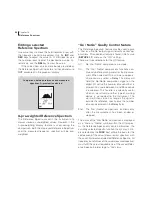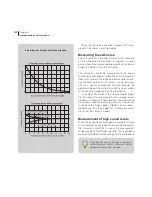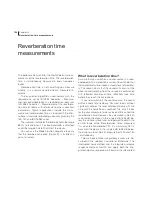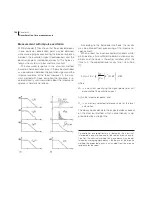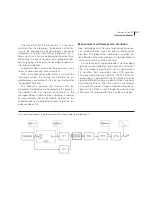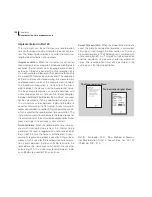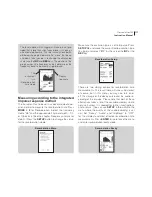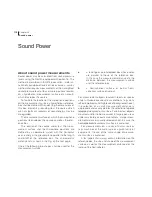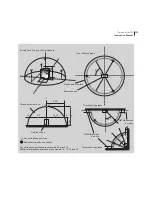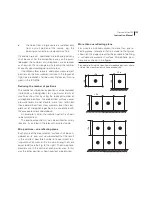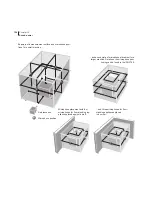
109
Norsonic Nor140
Instruction Manual
Excitation signals
Impulse excitation.
Excitation for the integrated im-
pulse response method may be any impulsive, broad-
band source with suitable low directivity. This may be
a pistol shot, an exploding paper bag or an exploding
balloon capable of creating enough sound energy in
the frequency range you need.
An advantage of using impulse excitation is that you
don’t have to carry heavy loudspeaker/amplifier com-
binations with you. In addition you will be able to rely
on battery operation alone with no need for mains volt-
age. By using noise excitation through a loudspeaker
you will more easily verify proper levels and directional
characteristics of the source.
Noise excitation.
When the interrupted noise method
is applied you have to use the signal from the optional
internal noise generator. (Option 10 - available on the
multi function socket on the left hand side of the instru-
ment) or an external noise signal. Feed the signal to a
suitable power amplifier and loudspeaker. The power
amplifier Nor280 and the dodecahedron loudspeakers
Nor275 and Nor276 may be applied. By using noise
signals through a loudspeaker it may be easier to obtain
a sufficiently loud sound level and to excite all the dif-
ferent reverberation modes of the room.
Swept Sine excitation.
The swept sine method also
makes use of the internal noise generator, power ampli-
fier and generator. The sine sweep signal covers the
frequency range from 42.2 Hz to 23.7 kHz. The sweep
is logarithmic and it is performed in 1.5 seconds. Data
acquisition takes 2.73 seconds. The signal sampling
rate is 48 kHz.
Minimum reverberation time possible
The frequency analysis in the form of 1/3- and 1/1- oc-
tave filters sets a lower boundary for the reverberation
times that can be measured. All frequency selective
devices such as a filter will have a response shortly
after removal of an input signal. This will create a virtual
reverberation time and the instrument can not meas-
ure below this limit. If the measured reverberation time
is below the lower limit for reliability, the value will be
marked by an adjacent question mark. The table be-
low shows the virtual reverberation times and the cor-
responding lower limits for a reliable measurement as
a function of frequency and bandwidth. The values of
these virtual reverberation times are increased slightly
to cover for strong fluctuations in the decay curves.
Maximum reverberation times
The longest reverberation time it is possible to meas-
ure is a function of the sampling speed of the rever-
beration curve. The default selection gives a maximum
reverberation time of 4 seconds with a sampling rate of
5 ms. Alternatively you can select 8, 16 or 32 seconds.
The sampling interval will be increased accordingly
from 5 ms to 40 ms. Please note that this will not nec-
essarily have a negative impact on the resolution and
accuracy of the reverberation time calculation where
the least square fit method is used.
Summary of Contents for nor140
Page 4: ......
Page 16: ......
Page 17: ...nor140 SOUND ANALYSER ...
Page 18: ......
Page 212: ...194 ...
Page 218: ......


